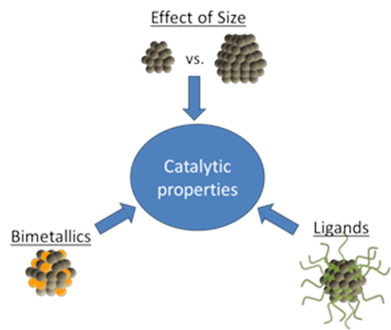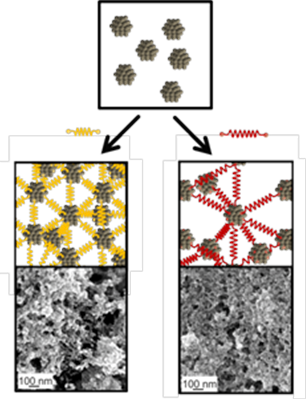
Startseite | Mitarbeiter | Forschung | Lehre | Veranstaltungen | Anfahrt | Intranet
Deutsch | English

Startseite | Mitarbeiter | Forschung | Lehre | Veranstaltungen | Anfahrt | Intranet
Deutsch | English
 Colloidal methods are used to study exclusively the influence of single parameters on the catalytic properties.
Colloidal methods are used to study exclusively the influence of single parameters on the catalytic properties.
 Nanoparticles can be linked with organic ligands (yellow and red) to porous networks that are catalytically active.
Nanoparticles can be linked with organic ligands (yellow and red) to porous networks that are catalytically active.
Catalysis is known as a key technology for green chemistry enabling for the reduction of the activation energy of a given chemical process, preventing waste of chemical resources, and for elimination of unwanted side reactions. One of the major research challenges for 21st century research in heterogeneous catalysis is to achieve fundamental understanding of selectivity (regio-, chemo-, and stereoselectivity) and furthermore the application of this knowledge in order to achieve a rational design of highly selective catalysts (see e.g. German Catalysis Society 2010, Roadmap for Catalysis Research in Germany).
In the case of metal nanoparticle catalysts the key to address this issue is to modify the particle surface properties. This can be done by e.g. tuning the particle size, shape, alloying with a second metal, or the use of ligands. In order to study the influence of only a single parameter it is prerequisite that it can be modified without changing any other parameter. Conventional methods such as incipient wetness are not suitable to achieve these synthetic aims, but colloidal methods allow for overcoming these limitation. Within our research we apply colloidal methods to prepare well-defined model catalysts in order to study the effect of particle size, metal composition and organic ligands on the catalytic properties.
A second research approach that we focus on is the linking of nanoparticles. This approach allows for the formation of porous, catalytically active nanoparticle networks, with the linking ligands acting as stabilizers for the particles to prevent sintering. This enables to use ligands as an alternative stabilizing approach in comparison to conventional support materials and thus to prepare novel catalytic materials.
Selection of Publications:
1 P. Sonström, M. Bäumer, Supported colloidal nanoparticles in heterogeneous gas phase catalysis: on the way to tailored catalysts, Phys. Chem. Chem. Phys. 13 (2011) 19270. DOI: 10.1039/c1cp22048a
2 L. Altmann, S. Kunz, M. Bäumer, Influence of organic amino and thiol ligands on the geometric and electronic surface properties of colloidally prepared platinum nanoparticles, J. Phys. Chem. C 118 (2014) 8925. DOI: 10.1021/jp4116707
3 S. Kunz, M.M. Maturi, I. Schrader, J. Backenköhler, M. Tschurl, U. Heiz, Same ligand – different binding mode: A way to control the binding of N-acetyl-cysteine (NAC) to Pt clusters, J. Colloid Interface Sci. 426 (2014) 264. DOI: 10.1016/j.jcis.2014.04.017
4 S. Kunz, P. Schreiber, M. Ludwig, M.M. Maturi, O. Ackermann, M. Tschurl, U. Heiz, Rational design, characterization and catalytic application of metal clusters functionalized with hydrophilic, chiral ligands: a proof of principle study, Phys. Chem. Chem. Phys. 15 (2013) 19253. DOI: 10.1039/c3cp53626b
5 E. Morsbach, J. Spéder, M. Arenz, E. Brauns, W. Lang, S. Kunz, M. Bäumer, Stabilizing catalytically active nanoparticles by ligand-linking: towards three dimensional networks with high catalytic surface area, Langmuir 30 (2014) 5564. DOI: 10.1021/la4049055